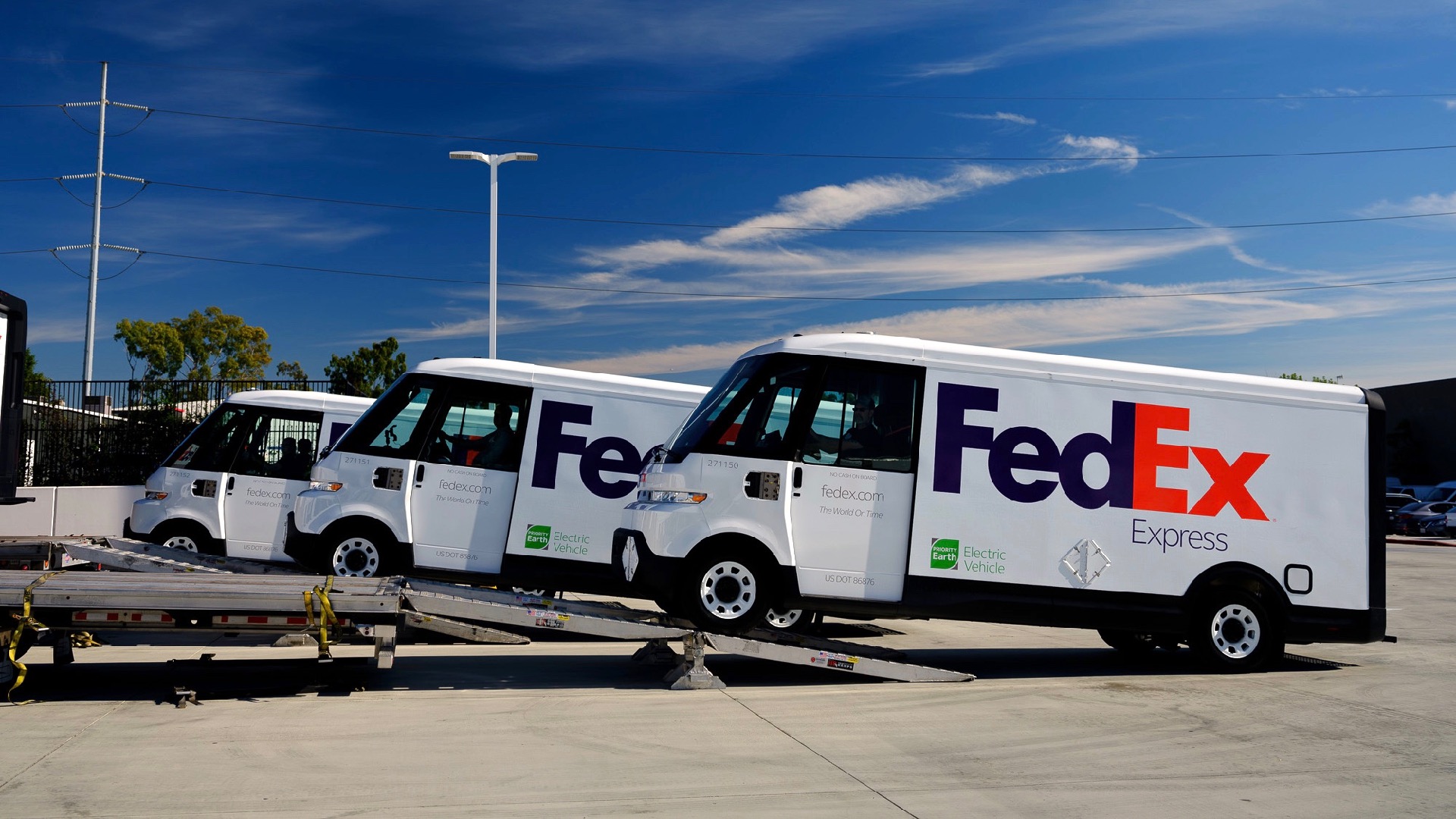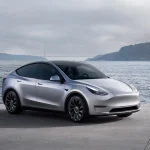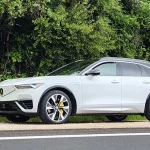

Electric vans from Stellantis, GM, Ford: Cleaner, quieter last-mile delivery takes connectednessElectric vans from Stellantis, GM, Ford: Cleaner, quieter last-mile delivery takes connectedness
Last-mile delivery vans are, increasingly, how we shop, how we get home services, and even how we get food delivered. And as the fleet of last-mile vans expands to meet this need, it’s largely going electric.
The wake-up call for how quickly this change might sweep the industry came in 2019, when Amazon announced plans to buy 100,000 electric vans from Rivian over many years—before the van was being produced, and before Rivian was making anything yet. Since then, electric vans from Ford and Stellantis have been confirmed for arrival in the next year—e-Transits and electric Ram ProMasters, respectively—while GM’s vans, under a new business called BrightDrop, have already been delivered in small numbers.
Beyond that, it’s worth noting the 2022 Ford F-150 Lightning, the 2023 Chevy Silverado, and the fully electric Ram 1500 due around 2024. Each of these are electric pickups that will be offered in fleet-oriented configurations.
This week, Stellantis announced that an agreement with Amazon will put “thousands of BEV ProMasters on the road every year” in the Amazon delivery fleet, showing that Amazon’s business arrangement with the company will continue in the era of electric vans, alongside Rivian. Likewise, GM’s BrightDrop announced that Walmart is agreeing to reserve 5,000 of its vans for last-mile delivery; FedEx has also reserved 2,500 of the vans and will buy up to 20,000 more over several years. Ford meanwhile announced last November that its E-Transit lineup was sold out for the first year of production, with around 25,000 reservations.
2022 Ram ProMaster
With smaller solutions from Electric Last Mile Solutions (ELMS) being delivered, from Canoo in the works, and larger upfitted ones from companies like Motiv and Lightning eMotors, the market expansion will continue for some time.
More money in the services than in sales margins?
Beyond sales of vans themselves, there’s an even bigger play. A 2020 report from the consultancy McKinsey & Co. projected that 10% to 15% of all U.S. fleet vehicles will be fully electric by 2030. While the cost of ownership will be 15% to 25% less than equivalent internal combustion models, there’s a lot of room for helping fleets get the most out of those gains; McKinsey predicted a $15 billion annual market forming by 2030 just in energy optimization to support electric fleet charging. In response, automakers are scrambling to keep that part of the business.
Already, Ford has its Ford Pro business catering to fleet customers, and it last year acquired Electriphi, a tech company that helps businesses charge their fleets in a way that minimizes costs and meets renewable energy targets. GM’s BrightDrop unit is offering a fleet management platform based on its Ultium Charge 360 platform, connecting logistics services with charging expertise.
2020 Fiat Ducato
Stellantis’ Ram Commercial is also stepping up. The electric version of the Ram ProMaster that arrives next year will be based on the existing model line, and will be closely related to an electric Fiat Ducato corporate cousin already sold in Europe. In preparation, for the 2022 model year, Ram Commercial has added a new telematics module to the entire lineup, no matter what propulsion system, to be future-proofed for such services.
Dave Sowers, head of Ram Commercial, recently talked us through some of the hurdles, why lighter last-mile delivery vans will be the first to electrify, and why such connected services are especially important for electric vans.
Fleet customers are different
“These (fleet) customers are more sophisticated; they actually do calculations about total cost of ownership—that’s acquisition minus disposal, it’s all the operational costs in between, and they keep very close track of it all,” explained Sowers. “So any improvement in operational cost is big.”
Sowers explained that customer have some anxiety about the time spent charging, but they’re looking at the usage cycle for most of these vehicles and it’s very predictable.
2022 Ram ProMaster
Stellantis has software that not only maps out what customers need in terms of charging habits, but it will even help them determine the hardware—charging and actual van battery size—that they need for the mission.
“One of the challenges or downsides on the EV side is that the mass of the battery is taking away from the payload,” he explained, noting that the ProMaster with a gasoline powertrain and a 9,350 GVWR (gross weight rating, often related to taxes) today has a 4,680-lb payload rating. “In order to achieve the same GVWR in an EV, a very large battery is needed and the payload goes down.”
“If you incorrectly size the battery and go for too much, you’re going to penalize yourself in terms of how much work you can do in a given day,” he summed, noting that’s where these tools are so important.
Sowers says that while the light-duty van fleet will electrify quickly, it will be awhile before we see special-use heavy-duty trucks, such as the bucket-trucks we see servicing power lines, or other industrial trucks, going fully electric in large numbers. That’s because those trucks depend on hydraulics with power needs that are tougher to define from day to day—even if electric power take-offs (ePTO) devices are ready for such vehicles.
No sooty circle of shame
There’s a greater urgency to electrifying doorstep delivery for one particularly pesky reason: It directly remedies what’s become a circle of shame for last-mile delivery—the plumes of black smoke left after repeated neighborhood diesel deliveries over the course of the day.
“That’s an issue of corporate responsibility and corporate reputation…so they’re going to be looking at how can we be the least intrusive in these neighborhoods, sound-wise and emissions-wise,” said Sowers.
It’s also a difference that’s very clear to see.
View original article at: “https://www.greencarreports.com//news/1134671_electric-vans-from-stellantis-gm-ford-cleaner-quieter-last-mile-delivery-takes-connectedness”
Add a comment Cancel reply
Categories
- Activism (1)
- Adventure (1)
- Advertising (2)
- Agriculture (1)
- Air pollution (4)
- Air transport (3)
- aluminium (2)
- Amazon (3)
- Animals (1)
- Apple (2)
- Architecture (1)
- Arctic (1)
- Artificial intelligence (1)
- Augmented Reality (1)
- Auto Detailing (1)
- autopilot (1)
- battery (31)
- Best summer holiday destinations 2022 (1)
- Bicycle (1)
- biodiversity (1)
- BMW (2)
- boat (1)
- Bus (1)
- Business (4)
- Buying Guides (1)
- car (7)
- Car industry (18)
- Car News (18)
- car rental (3)
- Car Reviews (4)
- Car sales (6)
- carbon emissions (15)
- carbon footprint (3)
- Carlos Ghosn (1)
- Cars (66)
- Central Europe (1)
- CES (2)
- charging station (11)
- Children (1)
- China (12)
- Citroën (1)
- city (1)
- City transport network (2)
- clean energy (2)
- Climate (1)
- climate change (9)
- Climate crisis (4)
- Climate emergency (2)
- climate protection (2)
- CO2 emissions (39)
- Company (3)
- Competition (1)
- Conscious travel (2)
- Contamination of water (1)
- Copper (2)
- cost of living (2)
- Cuba (1)
- Cuban politics (1)
- Cybertruck (1)
- Cycling (1)
- deforestation (1)
- delivery (3)
- Denmark (2)
- Detroit (1)
- Diesel (4)
- Diesel car (7)
- e-mobility (11)
- e-scooter (2)
- Eco travel (3)
- Eco-friendly (2)
- Ecology (1)
- Economy (1)
- El Niño (1)
- Electric (11,302)
- Electric boats (1)
- electric car (107)
- Electric Cars (499)
- Electricity (5)
- Electricity consumption (3)
- Electricity market (5)
- Elon Musk (21)
- emission (1)
- Emmanuel Macron (1)
- Energy (2)
- Energy low cost (1)
- energy transition (6)
- Entrepreneur (1)
- Environment (5)
- Environment pollution (1)
- Environmental protection (4)
- EU Policy (1)
- EU-China (2)
- Europe (7)
- Europe's energy crisis (1)
- European Commission (3)
- European economy (2)
- European Union (18)
- Euroviews (6)
- Eviction (1)
- EVs (37)
- F1 (1)
- factory (4)
- fake news (1)
- family (2)
- Ferrari (1)
- fertilizer (1)
- fine (penalty) (1)
- fire station service (1)
- flight (1)
- Flying car (4)
- Food security (1)
- Ford (1)
- Formula 1 (2)
- Fossil fuels (14)
- France (39)
- free trade (1)
- Fuel (3)
- Fuel cell electric vehicles FCEV (10)
- fuel crisis (2)
- Fuel Efficiency (3)
- fuel prices (1)
- Funeral (1)
- Gas (1)
- Gas Prices (1)
- gasoline price hike (1)
- German (1)
- Germany (8)
- Giorgia Meloni (1)
- Global warming and climate change (1)
- Good News (1)
- Greece (1)
- green energy (1)
- green new deal (1)
- Green transportation (17)
- Green Week (1)
- greenhouse gas emissions (6)
- Hanoi (19)
- Health (1)
- home (2)
- homelessness (1)
- Housing market (19)
- human rights abuse (1)
- Hybrid (2,283)
- Hybrids (116)
- Hydrogen (2)
- hydrogen vehicle (2)
- IAA Mobility (2)
- Iceland (3)
- incident (1)
- income (1)
- India (2)
- Indonesia (1)
- infrastructure (1)
- innovation (1)
- International relations (1)
- Investment (4)
- iPhone (1)
- Japan (1)
- Jobs (3)
- Joe Biden (4)
- Jubilee (1)
- Lampedusa (1)
- Las Vegas (1)
- lead petrol (2)
- Lithium (13)
- liveable cities (2)
- London (3)
- Luxembourg (1)
- Luxury (2)
- luxury goods (2)
- Luxury lifestyle (2)
- Manufacturing (5)
- Market (1)
- Markets (1)
- meat (1)
- Mercedes-Benz (39)
- Migrants (1)
- minerals (2)
- Mining (5)
- Mitsubishi Motors (1)
- Mobile World Congress (1)
- Mobility (10)
- Mobility Week (2)
- Mobility Week 2021 (1)
- Mobility Week 2023 (5)
- money (3)
- Motorcycling (2)
- Motorsport (1)
- Mountain (1)
- NASA (1)
- nature (2)
- net-zero (2)
- New technologies (6)
- Next Explainers (1)
- Next In data (2)
- Nigeria (1)
- Nissan (3)
- Norway (7)
- Nuclear Energy (1)
- nuclear fusion (1)
- Nuclear power plant (1)
- Odd (1)
- oil industry (1)
- Olaf Scholz (1)
- online shopping (1)
- Oslo (1)
- Paris (1)
- parody (1)
- Petroleum products (3)
- Peugeot (1)
- plastic (1)
- Poland (1)
- Politics (1)
- Pollution (44)
- Power Plant (1)
- prices (1)
- production (1)
- Profits (1)
- Prostitution (1)
- Public transport (4)
- Racing cars (1)
- Racism (1)
- Rail transport (2)
- rats (1)
- Raw material (1)
- Recycling (4)
- Renault (3)
- Renewable energies (6)
- renewable energy (6)
- Reykjavík (1)
- Rishi Sunak (1)
- road (36)
- Road infrastructures (1)
- Road safety (7)
- Road transport (20)
- road trip (1)
- Robot (1)
- Rolls Royce (1)
- Russia (1)
- Russia's invasion of Ukraine (2)
- Sadiq Khan (1)
- safari (1)
- Safety (1)
- Sale (1)
- sales (3)
- Scotland (1)
- self-driving (43)
- Semiconductor (1)
- Shares (1)
- Show (1)
- Silicone (1)
- Software (1)
- Solar energy (2)
- solar power (5)
- Space technology (1)
- Spain (1)
- start-up (3)
- Stock exchange transaction (1)
- Stock market activity (1)
- Stockholm (1)
- Strasbourg (1)
- Students (1)
- Summer Olympics (2)
- Sustainability (7)
- Sustainable city (3)
- Sustainable design (3)
- Sustainable development (1)
- Sustainable innovation (9)
- Sustainable technology (21)
- Sustainable tourism (4)
- Sweden (2)
- Tata Motors (2)
- Tax (37)
- Taxes (2)
- Taxi (1)
- Technology (55)
- Tesla (73)
- The Boring company (1)
- Tokyo Olympic Games 2020 (1)
- Toyota (4)
- trade (3)
- traffic (1)
- Trains (2)
- Transport (11)
- transportation (3)
- Travel destinations (1)
- Tunnel (1)
- Twitter (3)
- UBER (1)
- Ukraine war (1)
- Uncategorized (6)
- United Kingdom (5)
- United States (6)
- urban planning (2)
- Ursula von der Leyen (3)
- US politics (1)
- USA (1)
- vegan (1)
- vehicle (7)
- Video (4)
- Vietnam (19)
- Volkswagen (3)
- Volvo (2)
- waste (1)
- waste disposal (1)
- Water (1)
- Water resources (1)
- White House (1)
- wind energy (1)
- Wind turbine (1)
- Winter (2)
- work conditions (1)
- World Travel Market (1)
- Xiaomi (1)
Recent Posts
About us

Popular Tags
Related posts


Volvo EX30 in the test: Really a premium car at a volume price?

VW ID.7: Estate is not called Variant... It's a Tourer







